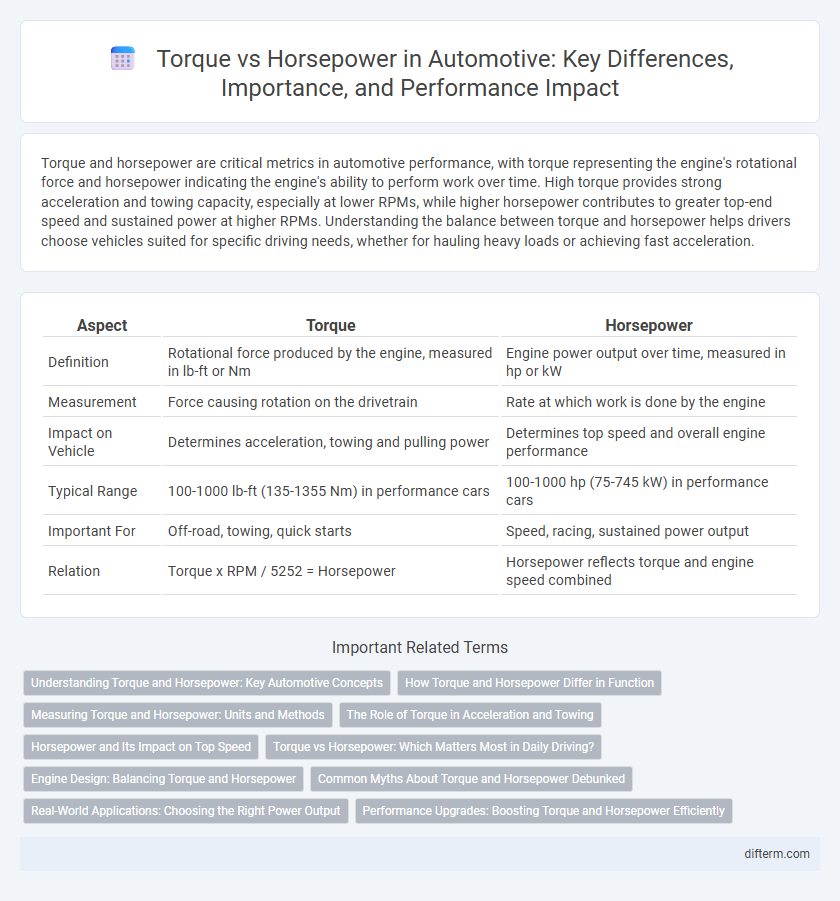Torque and horsepower are critical metrics in automotive performance, with torque representing the engine's rotational force and horsepower indicating the engine's ability to perform work over time. High torque provides strong acceleration and towing capacity, especially at lower RPMs, while higher horsepower contributes to greater top-end speed and sustained power at higher RPMs. Understanding the balance between torque and horsepower helps drivers choose vehicles suited for specific driving needs, whether for hauling heavy loads or achieving fast acceleration.
Table of Comparison
| Aspect | Torque | Horsepower |
|---|---|---|
| Definition | Rotational force produced by the engine, measured in lb-ft or Nm | Engine power output over time, measured in hp or kW |
| Measurement | Force causing rotation on the drivetrain | Rate at which work is done by the engine |
| Impact on Vehicle | Determines acceleration, towing and pulling power | Determines top speed and overall engine performance |
| Typical Range | 100-1000 lb-ft (135-1355 Nm) in performance cars | 100-1000 hp (75-745 kW) in performance cars |
| Important For | Off-road, towing, quick starts | Speed, racing, sustained power output |
| Relation | Torque x RPM / 5252 = Horsepower | Horsepower reflects torque and engine speed combined |
Understanding Torque and Horsepower: Key Automotive Concepts
Torque measures the rotational force an engine produces, directly influencing a vehicle's acceleration and towing capacity. Horsepower quantifies the engine's overall power output, reflecting how quickly work is performed and determining top speed potential. Understanding the relationship between torque and horsepower helps optimize vehicle performance based on driving needs and engine characteristics.
How Torque and Horsepower Differ in Function
Torque measures the rotational force produced by an engine, directly influencing a vehicle's ability to accelerate and tow heavy loads at low speeds. Horsepower represents the rate at which work is done, determining the vehicle's top speed and overall performance at higher RPMs. Understanding the distinction helps optimize engine tuning for either strong acceleration or sustained speed.
Measuring Torque and Horsepower: Units and Methods
Torque is measured in pound-feet (lb-ft) or Newton-meters (Nm) using devices like dynamometers that assess rotational force directly from the engine's output shaft. Horsepower is calculated based on torque and engine speed (RPM) through the formula HP = (Torque x RPM) / 5252, reflecting the engine's ability to perform work over time. Precise measurement equipment and standardized testing procedures ensure accurate assessment of both torque and horsepower for automotive performance analysis.
The Role of Torque in Acceleration and Towing
Torque is a critical factor in a vehicle's ability to accelerate quickly and tow heavy loads, as it represents the twisting force applied to the drivetrain. High torque enables engines to deliver strong low-end power, improving initial acceleration and maintaining steady pulling power during towing tasks. Vehicles with greater torque ratings often exhibit superior performance in challenging driving conditions such as steep inclines or hauling heavy trailers.
Horsepower and Its Impact on Top Speed
Horsepower plays a crucial role in determining a vehicle's top speed by measuring the engine's ability to perform work over time. Higher horsepower allows a car to overcome aerodynamic drag and mechanical losses more efficiently, resulting in faster acceleration and greater maximum velocity. While torque influences initial acceleration and pulling power, horsepower ultimately dictates the sustained speed and performance potential on highways and tracks.
Torque vs Horsepower: Which Matters Most in Daily Driving?
Torque delivers the immediate power needed for acceleration and hill climbing, making it crucial for daily driving scenarios like stop-and-go traffic. Horsepower determines a vehicle's ability to maintain higher speeds and overall performance on highways. Understanding the balance between torque and horsepower helps drivers choose vehicles that offer optimal drivability and efficiency for everyday use.
Engine Design: Balancing Torque and Horsepower
Engine design intricately balances torque and horsepower to optimize vehicle performance across different driving conditions. High torque engines deliver strong low-end power for acceleration and towing, while high horsepower engines sustain greater speeds and overall power output. Engineers tailor combustion chamber shape, camshaft profiles, and turbocharging to harmonize torque curves with horsepower peaks, achieving efficient and responsive drivetrains.
Common Myths About Torque and Horsepower Debunked
Torque and horsepower are often misunderstood; torque measures rotational force, while horsepower quantifies the engine's ability to perform work over time. A common myth is that higher horsepower always means better performance, but torque plays a crucial role in acceleration and towing capacity, especially at lower RPMs. Understanding the distinct functions of torque and horsepower helps debunk misconceptions about engine power and vehicle capability.
Real-World Applications: Choosing the Right Power Output
Torque delivers immediate rotational force essential for towing and off-road driving, making it crucial for vehicles like pickup trucks and SUVs. Horsepower determines overall engine power and affects acceleration and top speed, which benefits sports cars and highway driving. Selecting the right balance between torque and horsepower depends on the vehicle's intended use, whether it's hauling heavy loads or achieving high-speed performance.
Performance Upgrades: Boosting Torque and Horsepower Efficiently
Performance upgrades in automotive engineering focus on enhancing torque and horsepower to maximize vehicle acceleration and top speed. High-flow intake systems and performance exhausts increase airflow efficiency, boosting torque output at lower RPMs, while turbochargers and superchargers elevate horsepower by forcing more air into the combustion chamber. Optimizing engine tuning with ECU remapping further balances power delivery, ensuring efficient gains in both torque and horsepower without compromising reliability.
torque vs horsepower Infographic

 difterm.com
difterm.com